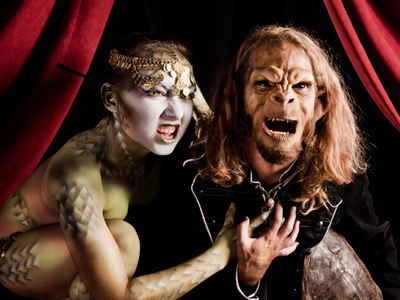
Ask the AI Tutor
Need help with Words Used in Connection with Literature 01? Ask our AI Tutor!
AI Tutor - Lucy
Connecting with Tutor...
Please wait while we establish connection

The leading character in a play is known as the protagonist.
Words Used in Connection with Literature 01
Narrators shape stories. Learn first person, third person, and omniscient viewpoints so you can spot who is telling the tale and why it matters.
1 .
Choose the correct definition for the following term.
Oxymoron
Oxymoron
Words of opposite meaning used for effect
Words of similar meaning used for effect
Words repeated for emphasis
Words repeated for similar sound effect
"Living death", for example, is an oxymoron
2 .
Choose the correct definition for the following term.
Rhythm
Rhythm
A measured beat
Random sounds
Two words which end with dissimilar sounds
Two words which end with similar sounds
Listen for rhythm in music, poetry and words
3 .
Choose the correct definition for the following term.
Setting
Setting
The characters of the tale
The language of the tale
The painted scenery used on stage
Where the tale takes place
Painted scenery is known as a stage "set"
4 .
Choose the correct definition for the following term.
First person narrative.
First person narrative.
Narrator using "he" as viewpoint to tell a tale
Narrator using "I" as viewpoint to tell a tale
Narrator using "it" as viewpoint to tell a tale
Narrator using "you" as viewpoint to tell a tale
A first person narrative, "I am .......", involves the reader
5 .
Choose the correct definition for the following term.
Third person narrative.
Third person narrative.
Narrator using "he", "she" or "it" as viewpoint
Narrator using "I" as viewpoint
Narrator using "they" as viewpoint
Narrator using "you" as viewpoint
Here is an example of third person narrative: "He was ten years old when ......."
6 .
Choose the correct definition for the following term.
Atmosphere
Atmosphere
The creation of a character in a tale
The creation of a mood or feeling in a tale
The scenery of the sky in a play
The scenery used in a round theatre
Atmosphere can be chilling, tense, relaxed, happy, sad, etc.
7 .
Choose the correct definition for the following term.
Protagonist
Protagonist
Leading character
Minor character
Playwright
The chorus
The protagonist is the main character
8 .
Choose the correct definition for the following term.
Stanza
Stanza
A particular viewpoint
Ideas or groups of ideas in poetry
The position of actors on stage
Verses or groups of lines in poetry
Poems might have regular stanzas of four, six or eight lines. Or they might have irregular stanzas
9 .
Choose the correct definition for the following term.
Enjambement
Enjambement
Breathing space before each line
Continuing sense from one line to the next
Stopping at the end of each line for a breath
Stopping sense at the end of each line
Poets use enjambement to let an idea flow on from one line to the next, allowing for emphasis on particular words
10 .
Choose the correct definition for the following term.
Imagery
Imagery
Imaginary words and phrases
Imagined words and phrases
Words making pictures in your mind
Words making pictures on your page
An image is in this sense a picture painted with words
**Unlimited Quizzes Await You! 🚀**
Hey there, quiz champ! 🌟 You've already tackled today's free questions.
Ready for more?
Ready for more?
🔓 Unlock UNLIMITED Quizzes and challenge yourself every day. But that's
not all...
not all...
🔥 As a Subscriber you can join our thrilling "Daily Streak" against other
quizzers. Try to win a coveted spot on our Hall of Fame Page.
quizzers. Try to win a coveted spot on our Hall of Fame Page.
Don't miss out! Join us now and keep the fun rolling. 🎉
**Unlimited Quizzes Await You! 🚀**
Hey there, quiz champ! 🌟 You've already tackled today's free questions. Ready for more?
🔓 Unlock UNLIMITED Quizzes and challenge yourself every day. But that's not all...
🔥 As a Subscriber you can join our thrilling "Daily Streak" against other quizzers. Try to win a coveted spot on our Hall of Fame Page.
Don't miss out! Join us now and keep the fun rolling. 🎉






